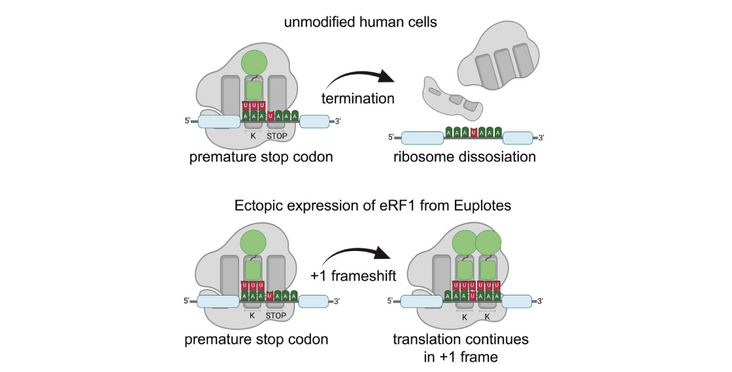Premature stop codons are the cause of human genetic diseases, and could be treated if the ribosome could with a frameshift overcome the stop signal. The Nowacki lab could now in mammalian cells by expressing the eukaryotic release factor 1 from an euplote, in which frameshifting frequently occurs, increase frameshifting at disease causing stop codons. Their findings were published in the article " Eukaryotic release factor 1 from Euplotes promotes frameshifting at premature stop codons in human cells" in the journal iScience.
Highlights
- Ectopic expression of Euplotes eRF1 in human cells increases frameshifting rate
- The N-terminal domain of Euplotes eRF1 is essential for frameshifting induction
- Increased frameshifting at a Tay-Sachs disease causative frameshift-stop sequence
- Full-length GATA3 protein translation in MCF-7 breast cancer model
Summary
Human physiology is highly susceptible to frameshift mutations within coding regions, and many hereditary diseases and cancers are caused by such indels. Presently, therapeutic options to counteract them are limited and, in the case of direct genome editing, risky. Here, we show that release factor 1 (eRF1) from Euplotes, an aquatic protist known for frequent +1 frameshifts in its coding regions, can enhance +1 ribosomal frameshifting at slippery heptameric sequences in human cells without an apparent requirement for an mRNA secondary structure. We further show an increase in frameshifting rate at the premature termination sequence found in the HEXA gene of Tay-Sachs disease patients, or a breast cancer cell line that harbors a tumor-driving frameshift mutation in GATA3. Although the overall increase in frameshifting would need further improvement for clinical applications, our results underscore the potential of exogenous factors, such as Eu eRF1, to increase frameshifting in human cells.
Read the Publication in iScience (Open Access)
Figure, highlights, summary and title from Stefanov (2024) iScience published under a CC BY-NC 4.0 license.
